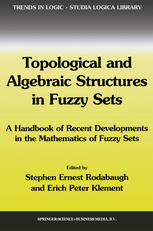

Most ebook files are in PDF format, so you can easily read them using various software such as Foxit Reader or directly on the Google Chrome browser.
Some ebook files are released by publishers in other formats such as .awz, .mobi, .epub, .fb2, etc. You may need to install specific software to read these formats on mobile/PC, such as Calibre.
Please read the tutorial at this link: https://ebookbell.com/faq
We offer FREE conversion to the popular formats you request; however, this may take some time. Therefore, right after payment, please email us, and we will try to provide the service as quickly as possible.
For some exceptional file formats or broken links (if any), please refrain from opening any disputes. Instead, email us first, and we will try to assist within a maximum of 6 hours.
EbookBell Team

4.3
18 reviewsThis volume summarizes recent developments in the topological and algebraic structures in fuzzy sets and may be rightly viewed as a continuation of the stan dardization of the mathematics of fuzzy sets established in the "Handbook", namely the Mathematics of Fuzzy Sets: Logic, Topology, and Measure Theory, Volume 3 of The Handbooks of Fuzzy Sets Series (Kluwer Academic Publish ers, 1999). Many of the topological chapters of the present work are not only based upon the foundations and notation for topology laid down in the Hand book, but also upon Handbook developments in convergence, uniform spaces, compactness, separation axioms, and canonical examples; and thus this work is, with respect to topology, a continuation of the standardization of the Hand book. At the same time, this work significantly complements the Handbook in regard to algebraic structures. Thus the present volume is an extension of the content and role of the Handbook as a reference work. On the other hand, this volume, even as the Handbook, is a culmination of mathematical developments motivated by the renowned International Sem inar on Fuzzy Set Theory, also known as the Linz Seminar, held annually in Linz, Austria. Much of the material of this volume is related to the Twenti eth Seminar held in February 1999, material for which the Seminar played a crucial and stimulating role, especially in providing feedback, connections, and the necessary screening of ideas.